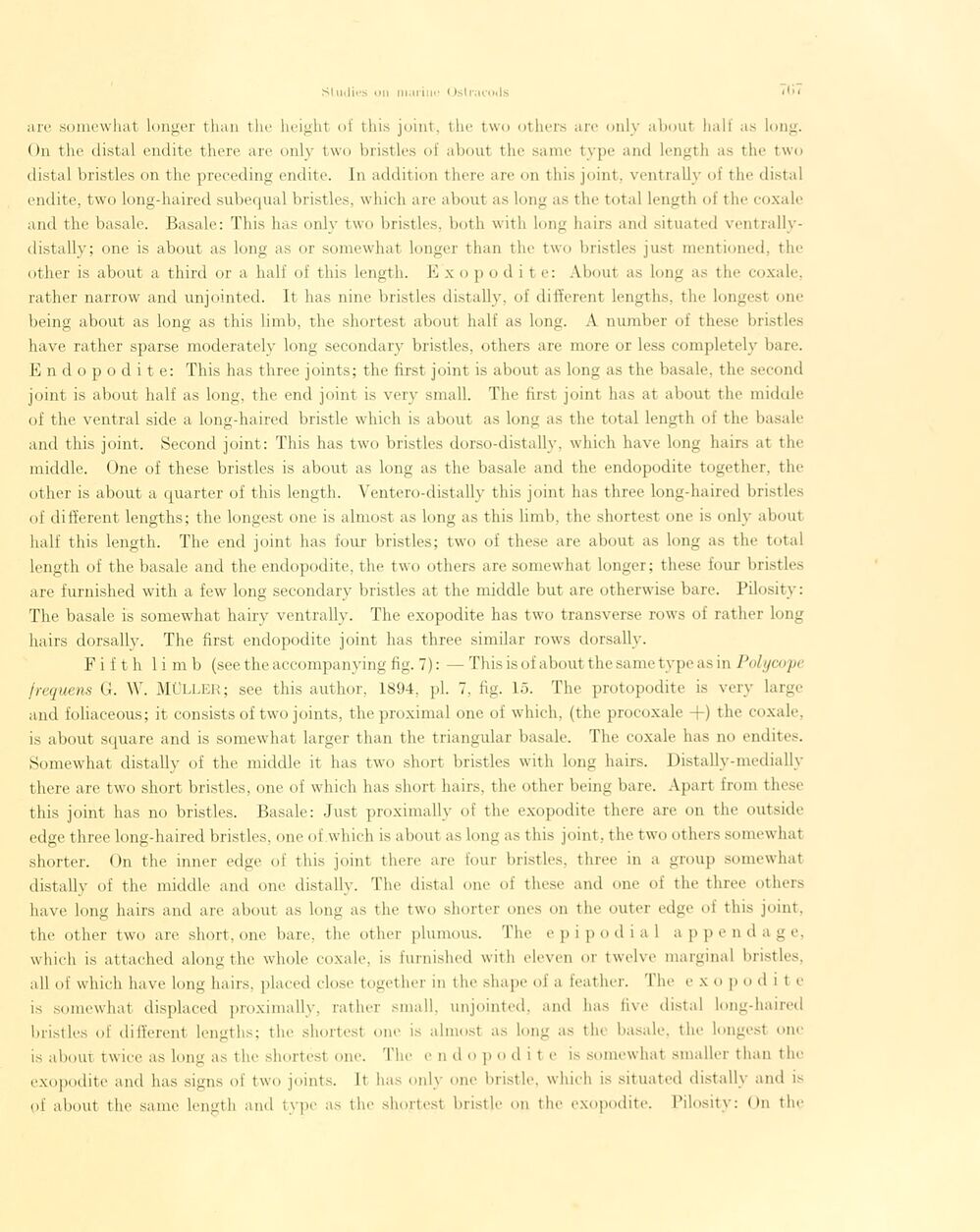
Full resolution (JPEG) - On this page / på denna sida - Sidor ...

<< prev. page << föreg. sida << >> nästa sida >> next page >>
Below is the raw OCR text
from the above scanned image.
Do you see an error? Proofread the page now!
Här nedan syns maskintolkade texten från faksimilbilden ovan.
Ser du något fel? Korrekturläs sidan nu!
This page has never been proofread. / Denna sida har aldrig korrekturlästs.
are somewhat longer than the lieigkt of this joint, the two others are only about half as long.
On the distal endite there are only two bristles of about the same type and length as the two
distal bristles on the preceding endite. In addition there are on this joint, ventrallv of the distal
endite, two long-haired subequal bristles, which are about as long as the total length of the coxale
and the basale. Basale: This has only two bristles, both with long hairs and situated
ventrally-distally; one is about as long as or somewhat longer than the two bristles just ment ioned, the
other is about a third or a half of this length. Exopodite: About as long as the coxale,
rather narrow and unjointed. It has nine bristles distally, of different lengths, the longest one
being about as long as this limb, the shortest about half as long. A number of these bristles
have rather sparse moderately long secondary bristles, others are more or less completely bare.
Endopodite: This has three joints; the first joint is about as long as the basale, the second
joint is about half as long, the end joint is very small. The first joint has at about the midale
of the ventral side a long-haired bristle which is about as long as the total length of the basale
and this joint. Second joint: This has two bristles dorso-distallv, which have long hairs at the
middle. One of these bristles is about as long as the basale and the endopodite together, the
other is about a quarter of this length. Ventero-distally this joint has three long-haired bristles
of different lengths; the longest one is almost as long as this limb, the shortest one is only about
lialf this length. The end joint has fom- bristles; two of these are about as long as the total
length of the basale and the endopodite, the two others are somewhat longer; these four bristles
are furnished with a few long secondary bristles at the middle but are otherwise bare. Pilosity:
The basale is somewhat hairy ventrally. The exopodite has two transverse rows of rather long
hairs dorsally. The first endopodite joint has three similar rows dorsali y.
F i f t h limb (see the accompanying fig. 7) : — This is of about the same type as in Polycope
frequens G. W. MÜLLER; see this author, 1894, pl. 7, fig. là. The protopodite is very large
and foliaceous; it consists of two joints, the proximal one of which, (the procoxale -f) the coxale,
is about square and is somewhat larger than the triangulär basale. The coxale has no endites.
Somewhat distally of the middle it has two short bristles with long hairs. Distally-medially
there are two short bristles, one of which has short hairs, the other being bare. Apart from these
this joint has no bristles. Basale: Just proximally of the exopodite there are on the outside
edge three long-haired bristles, one of which is about as long as this joint, the two others somewhat
shorter. On the inner edge of this joint there are four bristles, three in a group somewhat
distally of the middle and one distally. The distal one of these and one of the three others
have long hairs and are about as long as the two shorter unes on the outer edge of this joint,
the other two are short, one bare, the other plumous. The e p i p o dial a p p e n d a g e,
which is attached along the whole coxale, is furnished with eleven or twelve marginal bristles,
ail of which have long hairs, placed close together in the shape of a feather. The e x o p o d i t e
is somewhat displaced proximally, rather small, unjointed, and has five distal long-haired
bristles of diflerent lengths; the shortest one is almost as long as the basale, the longest
omis about twice as long as the shortest one. The c n d o p o d i t e is somewhat smaller than the
exopodite and has signs of two joints. It has only one bristle, which is situated distally and is
of about the same length and type as the shortest bristle on the exopodite. Pilosity: On the
<< prev. page << föreg. sida << >> nästa sida >> next page >>